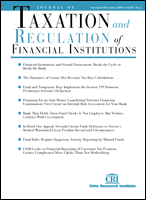Complete Issue
Author: Houman B. Shadab.
Source: Volume 25, Number 03, January/February 2012 , pp.1-60(60)

< previous article |return to table of contents
Abstract:
Our first article begins by taking a look back at the Treasury Department’s historic investment into financial institutions in 2008 under the Troubled Asset Relief Program (TARP). Jonathan Prokup and Dustin Covello argue that financial institutions could have claimed deductions for distributions made to Treasury because its preferred equity investments could have been characterized as debt for federal tax purposes. The authors’ analysis leaves the door open for financial institutions that receive similar government assistance under the Dodd-Frank Act’s resolution authority to treat preferred stock dividends as deductible interest payments. Next, John Sweet and John Taylor discuss recent Internal Revenue Service (IRS) actions taken against structured passive investment arrangements, which are a type of foreign tax credit related transaction that often involves banks or other financial institutions. As the authors note, recent actions indicate that the IRS has come a long way toward eliminating such transactions and, in light of the 2011 Mayo Foundation case, 1 taxpayers will have difficulty challenging the Service’s regulations in this area. Secured lenders sometimes seek to liquidate the collateral securing their loans. In this issue’s third article, Theodore Cohen provides a comprehensive discussion of the mechanisms through which lenders can recover value on their collateral, including voluntary wind down and surrender of collateral and private and public UCC Article 9 foreclosure sales. Mr. Cohen explains how lenders can use such mechanisms while minimizing liability to themselves, guidance that is particularly timely given the ongoing difficulties in the credit markets. In our fourth article, Jason Kreps and Thomas Lemmo discuss how patent assets can be monetized through securitization and collateralization techniques, with a focus on the potential problems arising from application of Article 9 of the Uniform Commercial Code. As the recent battle for Nortel’s patent portfolio indicates, market participants are interested in deriving value from patent assets. Finally, Luis Rodriguez in this issue’s last article provides principles for the IRS to follow in interpreting a statute that requires certain equity swap payments to be subject to withholding tax unless the swap is of a type that does not have the potential for tax avoidance.Keywords:
Affiliations:
1: Journal Editor, New York Law School.